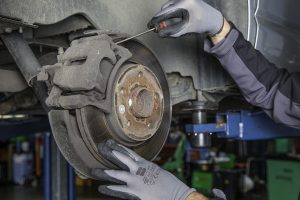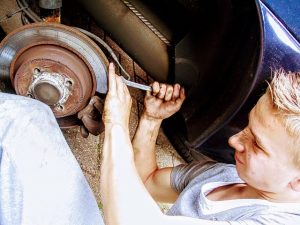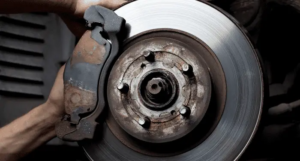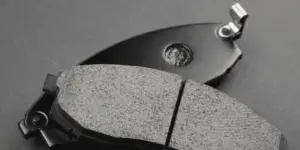
There are many integral parts to a car, and some of the most important, safety-wise, are the brakes. If you notice grinding, brake pads cutting into the rotor, or damaged parts, you need to fix it ASAP.
Fixing a problem with the brake pads cutting into the rotors can be as simple as smoothing down the rotor or adjusting the calipers and the alignment. It depends on the underlying cause of the damage.
For more information on identifying and fixing this problem – read on.
How Can I Tell If My Brake Pads Are Cutting Into My Rotor?
There are several warning signs that may indicate that your brake pads are cutting into your rotor. If you’re encountering any one of the following, you might want to take the tires off and have a look at the brakes.
- Squealing or screeching when you stop
- It takes longer to stop than usual, and the brakes feel somewhat non-responsive.
- Turning the car takes more effort
- You feel tremors when slowing the car down
- Leaking brake fluid
- Grabbing or pulling to one side while braking
Any of these is a sign that you have a problem. Once the car is up and the wheel is off, a simple visual inspection will let you know if the problem is your brake pads.
If you see long scratches or grooves in the rotor, then the brake pads are cutting into it, and it’s time to make some adjustments, or repairs.
What Causes Brake Pads To Cut Into The Rotor?
There are several reasons why the brake pads might cut into the rotors. Reasons include:
- Misaligned calipers
- Brake pads installed backwards
- Brake pads too close to the rotor
- Rotor is warped
- Pads need a refinishing
- Brake pads worn down too far.
Some of them are a matter of a small adjustment. Others are more serious and may need replacements, or even a mechanic’s touch to fix.
How Can I Tell Which Problem Is Causing Damage To My Rotors?

If you’re not comfortable checking mechanical issues, you should get a professional opinion. However, there are a few things that any car owner can look over, to get an idea of what problems they might be facing.
1. Misaligned Calipers:
Misaligned calipers can be difficult to diagnose. However, the easiest way to check is to examine the wear on the brake pads. Misaligned calipers will often result in uneven wear. The calipers may also bend slightly.
If the caliper adjustments are the problem, then it’s a matter of realignment. This can be a tricky prospect, unless you have some experience as a mechanic.
For an example of how to fix misaligned calipers, EricTheCarGuy provides an instructional YouTube video that can guide you through the process of examining and adjusting calipers. However, you may also want to search YouTube for videos more specific to your car and your specific brake system.
Once you’ve realigned the calipers to the best of your ability, it should smooth out the problem. Whether it does or not, it’s probably a good idea to have them examined and readjusted if necessary by a trained mechanic when you have the opportunity.
2. Brake Pads Installed Backwards:
If this is the problem, then the solution is easy – remove the brake pads and replace them in the proper alignment. If a professional replaces your brake pads, you probably won’t encounter this problem.
On the other hand, if you’re attempting a DIY brake replacement, it can happen. Double check the brake pads to make sure you’ve installed them correctly.
If the brake pads or the rotor become damaged during an installment, you may need to refinish or replace the pads and the rotor as well.
3. Brake Pads Too Close To The Rotor:
Brake pads should naturally be a centimeter or more away from the rotors, they’re in use. If the car is at rest and the brakes – the regular brakes, not the parking brakes – are touching the rotor, then they’re too close.
Brake pads shouldn’t be touching the rotor disc unless you’ve engaged the brake. If they are, it will cause constant friction and drag, and you’ll need to adjust them.
This can be as simple as adjusting the calipers, or it can be a bit more difficult. If the problem is the alignment of the rotor disc, for example, this might be harder.
There are YouTube videos that discuss adjusting the distance between the brake pads and the rotor disc for different models of cars. However, it may be easier to visit a mechanic for professional assistance.
4. Rotor Is Warped:
The rotor is supposed to be a flat disk of metal for the brake pads to press into for friction. If the rotor plate is warped, or is somehow positioned out of alignment, the result may be uneven wear and damage to both rotor and brake pads.
Determining a warp in the rotor may be difficult to do by eye. You may need to remove it and lay it on something flat to examine how much warp there is.
If the rotor itself isn’t warped, it’s a good idea to check the connections and make sure they’re in alignment so that the rotor presents a flat surface to the brakes when the brakes are in use. Assessing this may be more difficult, and it’s a good idea to have a professional assessment if you aren’t sure about the overall alignment of the rotors.
The rotor is supposed to be a flat disk of metal for the brake pads to press into for friction. If the rotor plate is warped, it needs to be bent, hammered, or ground back into the proper flatness and alignment.
This can be difficult to do without professional tools. We highly recommend having a professional mechanic do this part for you. Another option is to replace the rotor disc entirely, and double check the alignment of the connections while you’re at it.
5. Pads Need To Be Refinished:
In the course of their lifespan, brake pads commonly pick up dirt, grit and all manner of junk that can gum up the works.
Sometimes all the pads or the rotors need is a little bit of cleaning and refinishing to get everything back into the proper shape for optimal function. Most auto shops will take care of this for you with minimal fees, and some of them consider it a mandatory part of doing any brake work.
If you’re doing DIY, start by applying plenty of brake cleaner to brake pads and the rotor disc. Then clean and refinish the rotor disc. You’ll want to make sure it’s smooth so it aligns properly with the brake pads.
6. Brake Pads Are Worn Too Far:
Over time, brake pads wear down. If you don’t have a car with warning alerts to tell you that the brakes are wearing out, then the warning signs listed above might be the first hint you have.
Check the brake pads. If you can see bare metal, there’s probably too much wear and tear. If there’s less than a quarter-inch thickness of brake pad left, it’s dangerously worn.
Over time, brake pads wear down. Once the brakes have worn down to bare metal, or the last quarter inch, or to the indicator, then there’s really only one thing to do – replace them.
Replacing brake pads is one of the easiest repairs to do, and one of the most common. Just remove the tires, remove the old, worn out pads, and replace with new ones. This is a task that you can complete in a garage in an hour or so.
Frequently Asked Questions:
What if there are multiple issues, or I can’t tell what the issue is?
If worst comes to worst, you can take apart the entire assembly and replace both rotor disc and brake pads. However, it may be faster and easier to take the car to a professional first.
What if fixing the brakes and rotors doesn’t fix the problem?
If you’ve replaced the brakes and rotors, and you’re still getting grinding, pulling on the wheel, leaking fluids, tremors, or difficulty turning, then you probably have a different problem. Most likely culprits include the power steering system, or a misalignment of the wheels.
What if my brakes are good, but I still have squealing or other problems?
New brakes or rotors can take a little bit of time to wear in properly. It can take up to 500 miles of driving to smooth out the rough edges on new brake pads or rotor discs.













